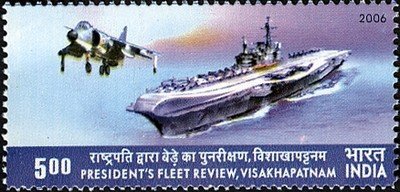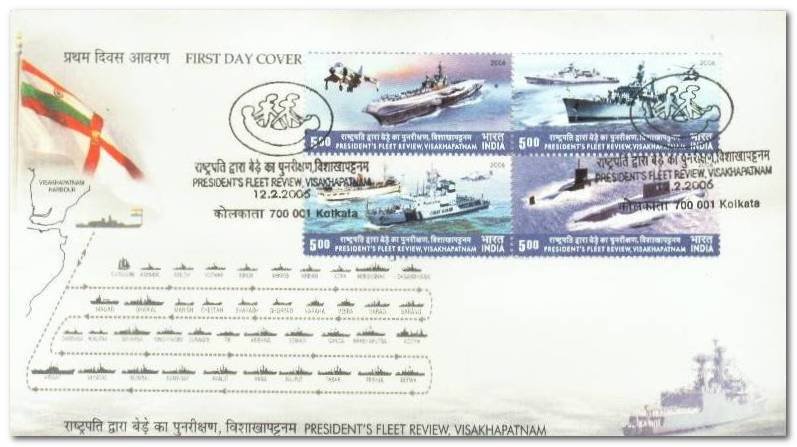President’s Review of the Fleet- INS “Viraat” and BAE Sea Harrier Fighter Plane

Technical Data
| Stamp Set | President's Review of the Fleet |
|---|---|
| Date of Issue | February 12, 2006 |
| Denomination | Rs. 5 |
| Quantity | 800,000 |
| Perforation | line 14 x 13¼ |
| Printer | Security Printing Press, Nashik |
| Printing Process | Photogravure |
| Watermark | No Watermark |
| Colors | Multicolor |
| Credit (Designed By) | Sh. Sankha Samanta |
| Catalog Codes |
Michel IN 2124 Stamp Number IN 2139a Yvert et Tellier IN 1889 Stanley Gibbons IN 2309 WADP Numbering System - WNS IN004.06 |
| Themes | Aircraft | Aviation | Military Forces | Ships | Warships |
Table of Contents
INS Viraat and the BAE Sea Harrier Fighter Plane
INS Viraat
- Commissioned: Originally commissioned in the British Royal Navy as HMS Hermes in 1959; later acquired by the Indian Navy and commissioned as INS Viraat on May 12, 1987.
- Role: Served as the flagship aircraft carrier of the Indian Navy, providing India with strategic air capability and force projection in the Indian Ocean region.
Features:
- Displacement of approximately 28,700 tons.
- Equipped to operate a mix of fighter jets and helicopters, including the BAE Sea Harrier.
- Had a ski-jump ramp to facilitate short takeoff for aircraft.
- Equipped with anti-aircraft and anti-missile systems, making it a formidable presence at sea.
Operational Highlights:
- Played a significant role in Operation Jupiter during the Sri Lankan Civil War and Operation Parakram in response to the 2001 Indian Parliament attack.
- Legacy: Viraat held the record for the longest-serving aircraft carrier in the world until its decommissioning on March 6, 2017, after 30 years of service in the Indian Navy and nearly 60 years of service overall.
BAE Sea Harrier Fighter Plane
- Introduction: The Sea Harrier, a naval variant of the Harrier Jump Jet developed by BAE Systems, was inducted into the Indian Navy in 1983 as part of the modernization efforts to support INS Viraat.
Capabilities:
- VTOL/STOVL: Capable of Vertical/Short Takeoff and Landing (VTOL/STOVL), allowing operations on aircraft carriers with shorter flight decks.
- Armament: Equipped with air-to-air missiles like Matra Magic II and AIM-120 AMRAAM, as well as air-to-surface missiles, rockets, and bombs.
- Radar and Avionics: Initially equipped with the Blue Fox radar, later upgraded to the more advanced Blue Vixen radar system.
Operational Role:
- Primarily served in fleet defense and reconnaissance roles. The Sea Harrier’s maneuverability and VTOL capability made it highly suitable for operations in the Indian Ocean.
- Retirement: The Indian Navy retired its Sea Harriers in 2016, phasing them out in favor of modern fighters like the MiG-29K.
INS Viraat and Sea Harrier Legacy
INS Viraat and the Sea Harriers together represented the backbone of India’s maritime air power for decades, contributing immensely to India’s defense strategy. The pairing of Viraat with Sea Harriers was symbolic of India’s naval prowess and commitment to securing its maritime interests.
First Day Cover

